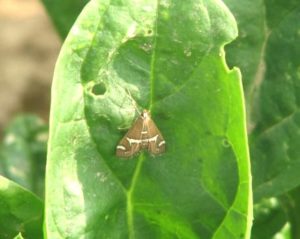Note: This will be the final regular edition of the Vegetable IPM Update for 2020. We will post alerts should special pest situations arise.
Sweet Corn
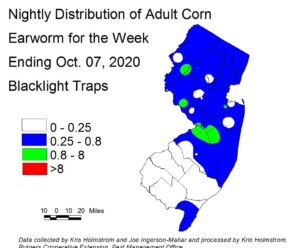 Corn earworm (CEW) moth captures continue to decline, although with temporary increases on warm nights. Growers should consider this pest to still be at moderate population levels in the state, with higher risk during stretches of warmer nights. The current population poses a threat to silking corn. Blue areas on this map (see map at left) represent a 4-5-day spray schedule. The low catches in the southern county blacklight traps are contradicted somewhat by the pheromone trap network. For further information on CEW activity, see pheromone trap information below.
Corn earworm (CEW) moth captures continue to decline, although with temporary increases on warm nights. Growers should consider this pest to still be at moderate population levels in the state, with higher risk during stretches of warmer nights. The current population poses a threat to silking corn. Blue areas on this map (see map at left) represent a 4-5-day spray schedule. The low catches in the southern county blacklight traps are contradicted somewhat by the pheromone trap network. For further information on CEW activity, see pheromone trap information below.
The highest nightly trap catches of CEW in black light traps for the week ending 10/07/20 are as follows:
| Crosswicks 3 | Califon 1 | Green Creek 1 |
| Hackettstown 2 | Clinton 1 | Milford 1 |
| Sergeantsville 2 | Eldora 1 | Milltown 1 |
| Bellemeade 1 | Georgetown 1 | Oldwick 1 |
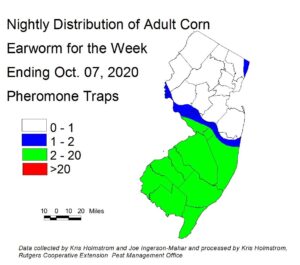 A similar temperature-based reduction in CEW pheromone catch occurred this past week (see CEW pheromone map at left). While northern county blacklights have still captured low but steady numbers of CEW, pheromone traps in the same region are catching almost nothing. This is likely due to some extent to the fact that there is little viable corn near which to place the traps. There were significant catches in several southern county pheromone traps, which has caused this pheromone map to appear to represent a nearly inverted situation from that indicated by the blacklight network. The green area on this map signifies a 4-day silk spray schedule. Taken together, both trap networks indicate a steady, low-to-moderate population which continues to be an economic threat. The number of pheromone traps deployed is much lower, resulting in much broader color bands on the map. It is important to use effective materials to manage this pest on silking corn. Insecticides in the IRAC 28 class (Coragen, Besiege, Exirel) and IRAC 5 (Radiant, Blackhawk, Entrust (OMRI approved)) remain among the most useful insecticides against CEW.
A similar temperature-based reduction in CEW pheromone catch occurred this past week (see CEW pheromone map at left). While northern county blacklights have still captured low but steady numbers of CEW, pheromone traps in the same region are catching almost nothing. This is likely due to some extent to the fact that there is little viable corn near which to place the traps. There were significant catches in several southern county pheromone traps, which has caused this pheromone map to appear to represent a nearly inverted situation from that indicated by the blacklight network. The green area on this map signifies a 4-day silk spray schedule. Taken together, both trap networks indicate a steady, low-to-moderate population which continues to be an economic threat. The number of pheromone traps deployed is much lower, resulting in much broader color bands on the map. It is important to use effective materials to manage this pest on silking corn. Insecticides in the IRAC 28 class (Coragen, Besiege, Exirel) and IRAC 5 (Radiant, Blackhawk, Entrust (OMRI approved)) remain among the most useful insecticides against CEW.
The highest nightly trap catches of CEW in pheromone traps for the week ending 10/07/20 are as follows:
| Berlin 12 | Crosswicks 4 | Dayton 1 |
| Springdale 10 | Eldora 3 | Snyder Farm (Hunterdon) 1 |
| Green Creek 8 | Califon 1 |
Silking Spray Schedules*:
South – 4 days
Central – 4 days
North – 4-days
*These recommendations are based on regional catches. Adhere to tighter spray schedules if indicated by local trap catches. Synthetic pyrethroids alone should NOT be used for corn earworm (CEW) protection on silking corn, or for fall armyworm (FAW) management at any stage. Control with these materials is very inconsistent.
Cole Crops
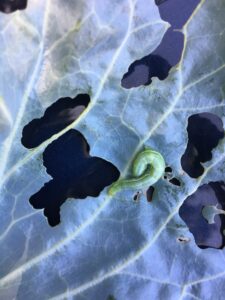 Fall plantings of cole crops are well underway at this time, and are frequently infested by imported cabbageworm (ICW) and diamondback moth (DBM) larvae. At this time, cabbage looper (CL-photo at left) and cross striped cabbage worm (CSCW-photo at right) are also causing
Fall plantings of cole crops are well underway at this time, and are frequently infested by imported cabbageworm (ICW) and diamondback moth (DBM) larvae. At this time, cabbage looper (CL-photo at left) and cross striped cabbage worm (CSCW-photo at right) are also causing injury to these crops.
injury to these crops.
Check 5 consecutive plants each in 10 random locations throughout the planting. Consider treating if caterpillars are found on 10% or more plants that are in the 0-9 true leaf stage. From 9-leaf to the early head stage (in broccoli, cauliflower, and cabbage) infestations up to 20% may be tolerated. Once heads begin to form, a 5% threshold should be observed to protect the marketable portion of the plant. For leafy greens such as collards and kale, 10% plants infested is the threshold throughout.
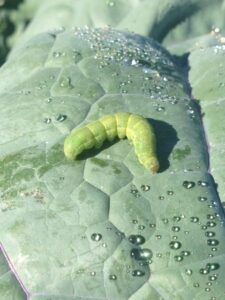 Some populations of DBM are resistant to carbamate and synthetic pyrethroid insecticides. The lack of DBM control with these insecticides has been noted in NJ previously. It is important to distinguish between common cole crop pests for this reason. DBM larvae grow to a length of approximately 0.5”, and taper toward both ends (see photo at right). These caterpillars thrash violently when disturbed. Newer chemistries that specifically target caterpillar pests are effective against DBM as well as all other caterpillar pests of cole crops, including beet armyworm (BAW-see photo at right), another species with exhibiting pyrethroid resistance. These materials include (active ingredient – trade name (IRAC* code)):
Some populations of DBM are resistant to carbamate and synthetic pyrethroid insecticides. The lack of DBM control with these insecticides has been noted in NJ previously. It is important to distinguish between common cole crop pests for this reason. DBM larvae grow to a length of approximately 0.5”, and taper toward both ends (see photo at right). These caterpillars thrash violently when disturbed. Newer chemistries that specifically target caterpillar pests are effective against DBM as well as all other caterpillar pests of cole crops, including beet armyworm (BAW-see photo at right), another species with exhibiting pyrethroid resistance. These materials include (active ingredient – trade name (IRAC* code)):
Spinosad/Spinetoram – Entrust(OMRI)/ Radiant (5)
Chlorantraniliprole – Coragen (28)
Cyantraniliprole – Exirel (28)
Crucifer downy mildew has been detected on collards recently. While all cole crops are hosts, collards are frequently the most heavily affected. Crucifer downy mildew results in small dark lesions with yellow borders on the upper leaf surface. On the lower leaf surface, whitish sporulation is often present (see photo at left). Preventive fungicide applications are advisable for this disease. For control materials, see the Cole Crop Section of the 2020 Commercial Vegetable Recommendations.
Spinach, beets and chard
Hawaiian beet webworm (HBWW) moths have been detected in increasing numbers on central and southern NJ farms. Injury has been reported on spinach in Hunterdon County. The moths are quite numerous where they have been found. Farmers with spinach, beets, and chard should check their fields for the presence of webbing and feeding injury. These are small migratory moths usually occurring in mid-to-late summer. Their favored host is the pigweed, Amaranthus sp., but they are capable of causing defoliation and contamination to crops. Since they are migratory and have a short life cycle they can rapidly appear and cause extensive damage to crops unnoticed.
Allium Leafminer
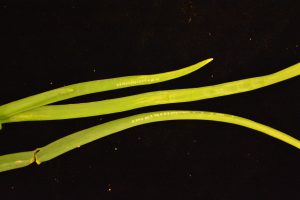 It is allium leafminer (ALM) season again, and growers of leeks, scallions, etc. should be protecting crops either with row covers, or with labeled insecticide appliations targeting adults. Egg-laying scars have been detected on various allium crops in recent weeks. See photo at right, of adult egg-laying scars on scallion leaves. Spinosyn materials (Radiant, Entrust (OMRI approved)), pyrethroids (Mustang Maxx, Warrior), neonicotinoids (Scorpion, Venom) and the insect growth regulator Trigard are labeled for miner control. The diamide, Exirel, is permitted in NJ under a 2ee label as well.
It is allium leafminer (ALM) season again, and growers of leeks, scallions, etc. should be protecting crops either with row covers, or with labeled insecticide appliations targeting adults. Egg-laying scars have been detected on various allium crops in recent weeks. See photo at right, of adult egg-laying scars on scallion leaves. Spinosyn materials (Radiant, Entrust (OMRI approved)), pyrethroids (Mustang Maxx, Warrior), neonicotinoids (Scorpion, Venom) and the insect growth regulator Trigard are labeled for miner control. The diamide, Exirel, is permitted in NJ under a 2ee label as well.

